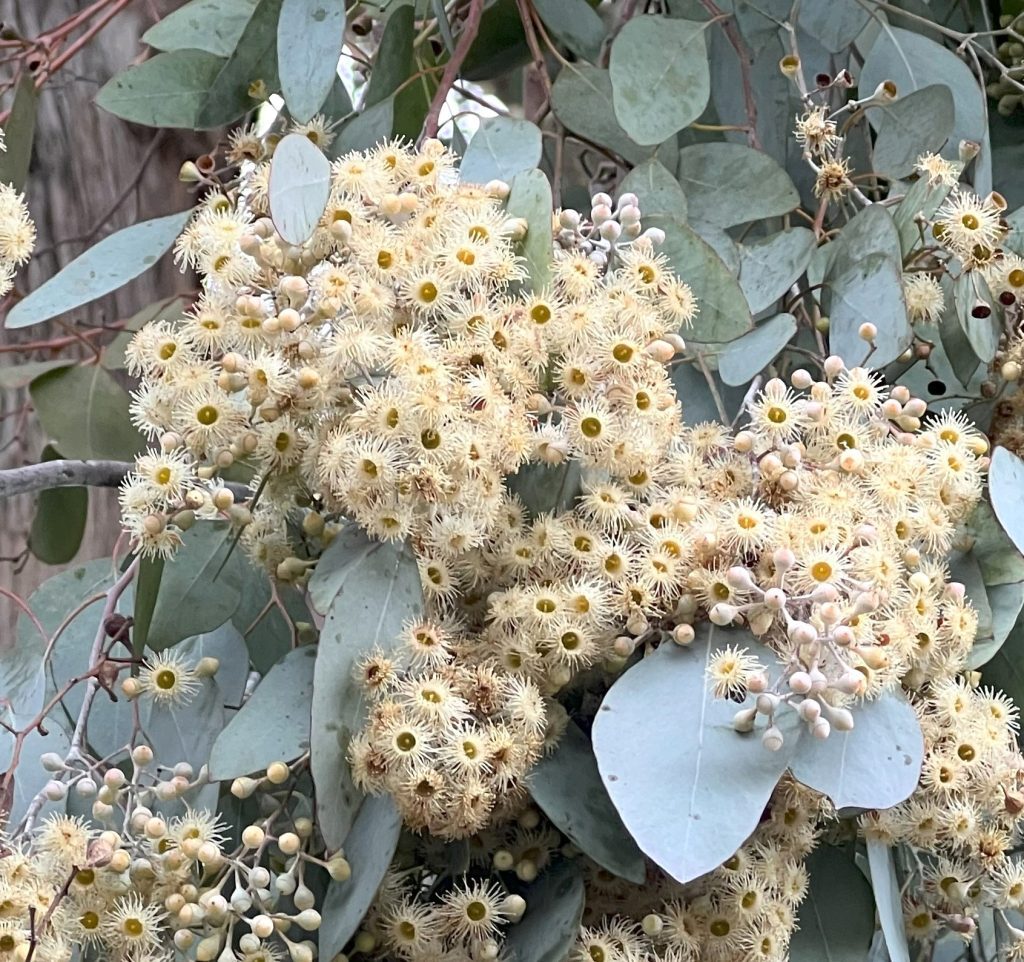The Silver Dollar Gum is one of the best small- to medium-sized broad-leafed evergreen trees for Santa Barbara. It is a stunning addition to any garden or landscape in our area, because it displays a lovely sculptural branch structure, a wonderful floral display in winter, and a striking gray-green foliage year-round.
As a young tree, it usually has a single trunk and an upright growth habit; as it ages, it will spread laterally. It grows relatively slowly up to a height of 50-feet or taller and to a spread of 40-feet. The crown is covered with unique foliage that will change dramatically, in shape and color, over time.
Juvenile leaves are circular in shape with a bluish-gray to silver color; hence the common name, “Silver Dollar Gum”. As the leaves mature, they elongate and turn a gray to green-gray color. Mature leaves are lanceolate-shaped (up to 3½-inches in length and 1¼-inches in width), occur alternately on the twigs, and have reddish colored petioles (stems), leaf margins, and midribs. Leaves of any age have oil blisters scattered on their surfaces; when the leaves are crushed, they exude the delightful fragrance of eucalyptus oil.
From late December through February, eye-catching flowers can completely cover the tree crown. Creamy-white flowers (½ inches in diameter) form in large clusters on the ends of branches. These are “perfect”, meaning each flower has both male parts (stamens) and female parts (pistils). Rather than bearing petals on their outer rims, the flowers only display their stamens, which provide a soft fluffy appearance. The flowers bloom in such great abundance that they attract large numbers of bees, which then produce delicious eucalyptus-scented honey.

After the flowers are pollinated, seed capsules form. The tiny (¼-inch long and 1/8-inch wide) capsules are goblet-shaped and dark brown. Each capsule can contain dozens of seeds that are smaller than poppy seeds!
As the tree matures, the bark will also change form and color. It starts as a smooth textured surface with a mottled gray-brown color. With age, it can change to become slightly fissured with a gray-white color or deeply fissured, fibrous, and flaky with a gray-brown color. Occasionally, the outer bark peels off and exposes a cream-colored inner bark.
The Silver Dollar Gum is endemic to Australia – to the slopes and plateaus of central and southeastern New South Wales – and to the rocky hills and ridges of eastern Victoria.
Locally, it is known by the common names of either “Silver Dollar Gum” or “Silver Dollar Eucalyptus”. In Australia, the common names used are “Red Box” or “Australian Beech”. The word “gum” for the common names has been given to many Eucalyptus species; it refers to the gummy globs of sap that will ooze from wounds to the trunks. The use of the word “gum” is a slightly dangerous misnomer, since the sap is inedible and should not be chewed or ingested.

Whatever the common name, its botanical name is Eucalyptus polyanthemos. The genus name, Eucalyptus, is a combination of the Greek words, “eu” (meaning “well”) and “kalypto” (meaning “covered”) – and refers to the caps that cover and protect the flower buds. The specific epithet, polyanthemos, is a combination of the Greek words “poly” (meaning “many”) and “anthemom” (meaning “flowers”) – and refers to the profusion of its flowers.
In California, the Silver Dollar Gum is a highly desirable landscape tree, because of its tolerance to drought and its adaptability to poor and rocky soils. Adding to its appeal is the fact that it is resistant to oak root fungus (Armillaria mellea), to major insect pests, and to significant plant diseases. It is cold tolerant to temperatures down to 15 degrees F.
Its wood is very hard, dense, and rot resistant, so it is prized as a lumber in Australia for use as railroad ties, fence posts, and firewood. In the florist trade, the juvenile leaves and twigs are valued for use in floral arrangements.
The Silver Dollar Gum makes a distinctive landscape tree. It should be planted in full sun. It will require irrigation during the dry seasons for only the first two years after planting. After that, it should thrive with our normal rainfall. It is adaptable to almost any soil type and fits in well with other Mediterranean-climate plants. It has few maintenance requirements, needing pruning only for branching structure, shaping, or reduction of its size to fit the scale of a smaller garden. This aesthetically pleasing tree makes a lovely and sustainable addition to any landscape.
Mature Silver Dollar Gums can be seen in the Visitor Center Parking Lot on Cabrillo Boulevard (at Garden Street), on San Rafael Avenue, in Shoreline Park, in the Santa Barbara Harbor Parking Lot, and in the 1300 Block of Punta Gorda Street.
Tree-of-the-Month articles are sponsored by Santa Barbara Beautiful, whose many missions include the increase of public awareness and appreciation of Santa Barbara’s many outstanding trees and, in a long-time partnership with the City Parks & Recreation Department, the funding and planting of trees along the City’s streets.
Those who wish to honor a special someone can do so with an attractive commemorative marker that will be installed at the base of an existing street tree in the City of Santa Barbara. Because Santa Barbara Beautiful has participated in the planting to date of over 13,000 street trees, there are plenty of trees from which to choose! Application forms are available on the Santa Barbara Beautiful website, www.sbbeautiful.org.
Article and Photos by David Gress















